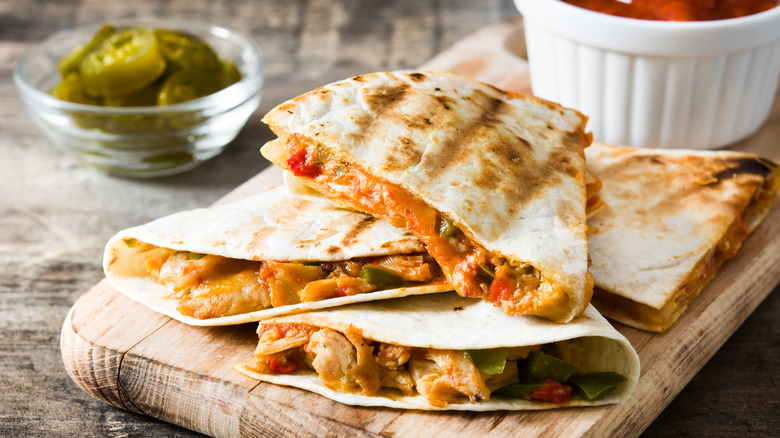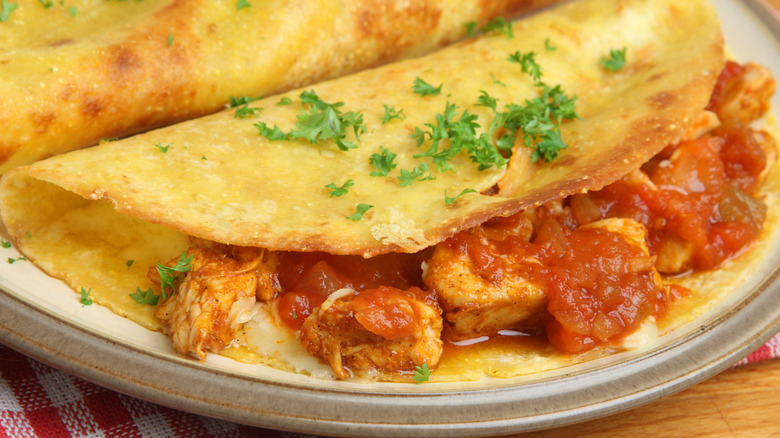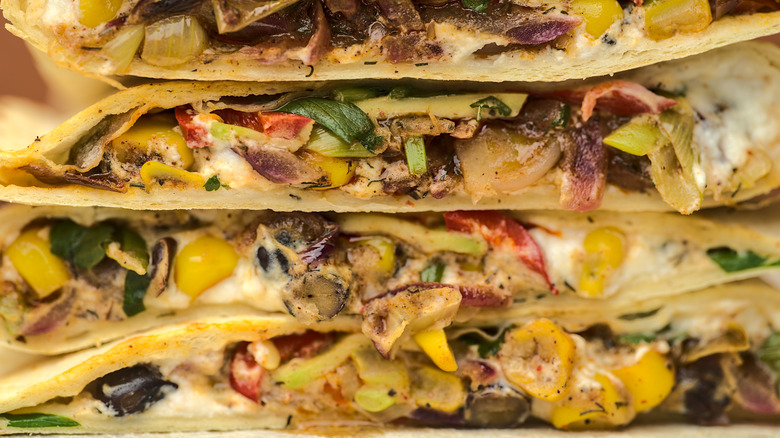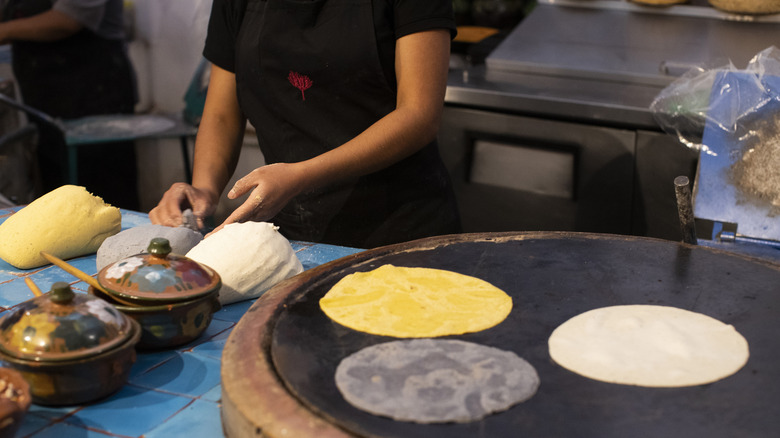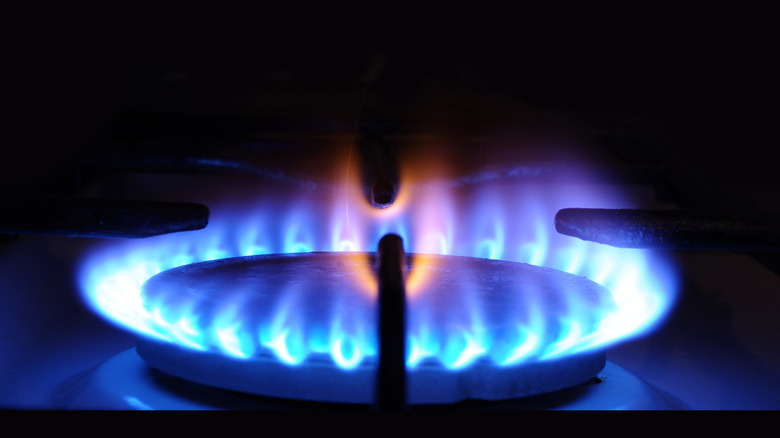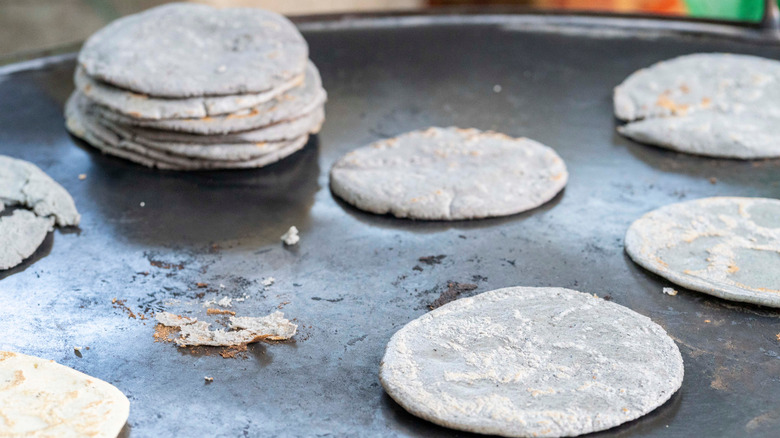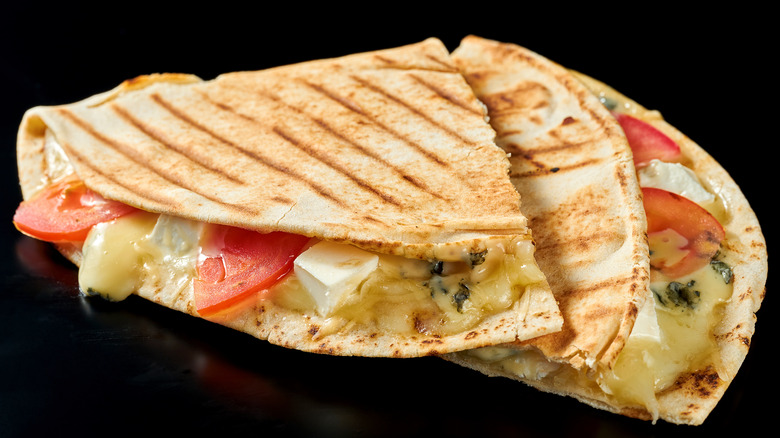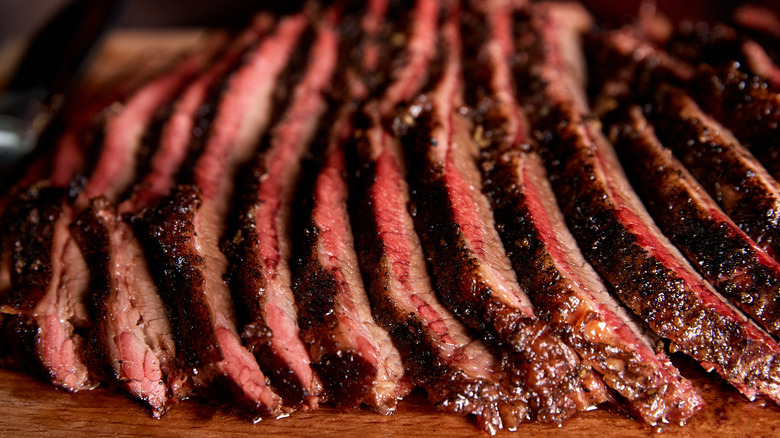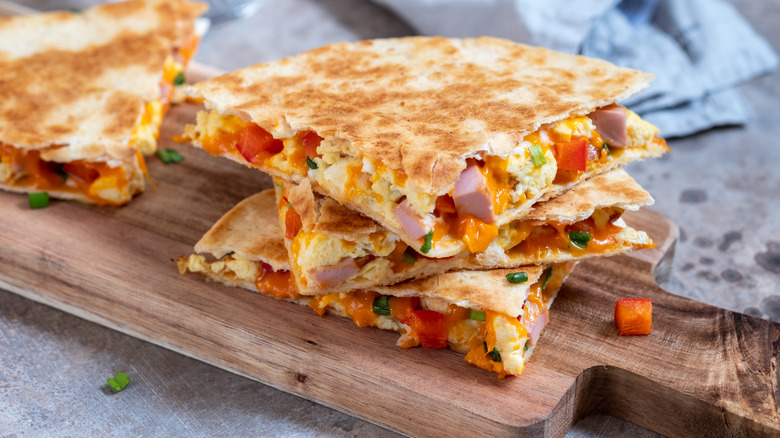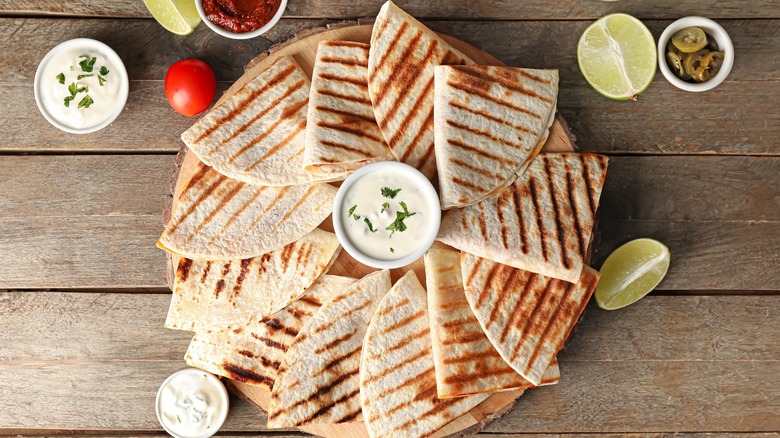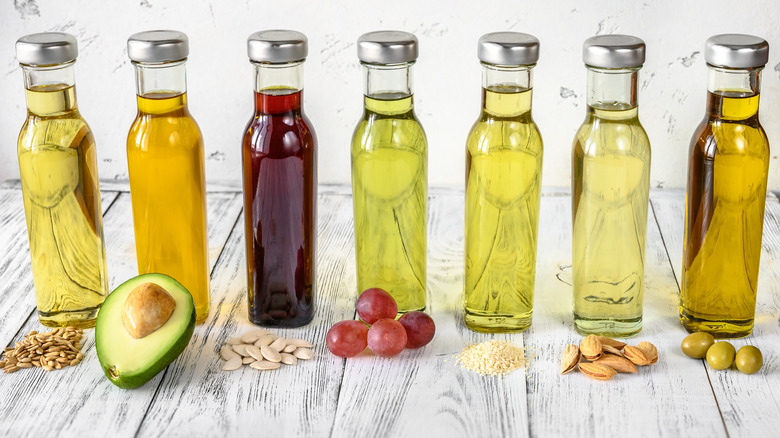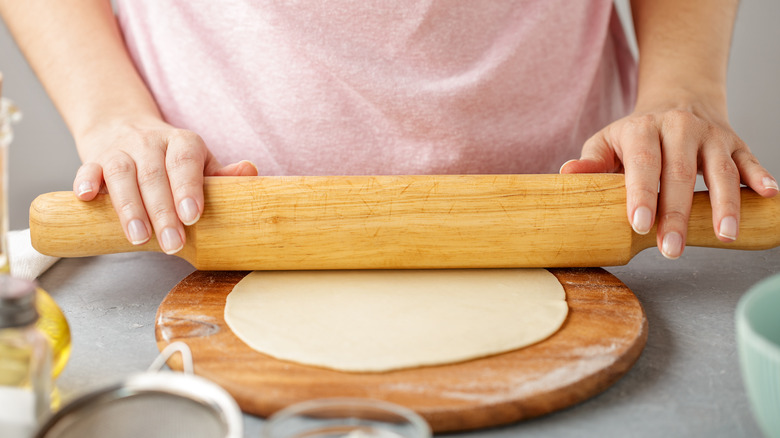11 Mistakes Everyone Makes With Quesadillas
Quesadillas may be one of the most fabulous foods ever invented. They're quick, customizable, and even the pickiest kids will devour them. If you find you have no clue what to do with leftovers, quesadillas will save you. Anything can make delicious quesadillas, even pot roast. Roast chicken might be great one night but then sits in the fridge. Combine it with cheese for a simple quesadilla, or dress it up with beans, veggies, and guacamole if that's your jam.
The Aztecs are credited with the creation of quesadillas. Initially a tribe of nomads, they settled in central Mexico in the 14th century and became successful farmers. Corn, or maize, was a primary crop, and they stuffed corn tortillas with pumpkin or squash for a sweet treat. Spanish settlers came to the region in the 16th century and raised livestock. They made cheese from sheep, cows, and goats, and quesadillas evolved into the kind we enjoy today.
Although quesadillas are simple, there are still ways to mess them up. The finest quesadilla is crisp and easy to handle, so let's explore common mistakes that turn a beautiful quesadilla into an unappetizing mess.
1. Using two tortillas
If you're new to making quesadillas, it could seem tempting to make giant quesadillas by taking two large flour tortillas and putting filling on one, topping it with the other, and trying to fry it. Unfortunately, doing so invariably makes a mess when the filling spills on the flip. You can use two tortillas if you plan to bake them in the oven, but we all know that fried quesadillas taste better.
One flour tortilla is far easier to flip. Put the fillings on half the tortilla and fold it over for an easy quesadilla that crisps up and turns without spilling. When the job is neater and faster, it won't matter that you need to make more quesadillas for your crew.
Corn tortillas are the exception to this rule, because they are not only smaller but tend to crack if you fold them. Making quesadillas with two corn tortillas is fine, but stick to fewer fillings until you have flipping down pat.
2. Using too many fillings
There are endless options for quesadillas, but do avoid acting like the kid in a candy store. It's tempting to want to stuff your tortilla with meat, cheese, veggies, beans, and, oh! what about some avocado slices? But always remember, you're going to have to flip that bad boy, and nothing ruins a quesadilla faster than everything sliding into the pan on the flip.
Beginners can start with cheese. Shredded cheese melts faster, but feel free to mix varieties you enjoy. Keep fillings away from the edge, so there's some room for melting and be sure to leave it a few minutes before flipping to crisp the tortilla, melt the cheese, and make the flip as easy as possible.
Add more toppings if a cheese quesadilla sounds too simple, but The Kitchn recommends limiting the total amount of filling to 1/2 cup. That may seem skimpy if you have a lot of ingredients to choose from, but quesadillas are handheld bites, not super subs. More flavor comes from serving dips like salsa, sour cream, or guacamole.
3. Overthinking your tortilla choices
When it comes to the corn or flour tortilla debate, most people do have a preference. However, don't limit your quesadillas with the thought that one type is more authentic cuisine. Corn was a staple crop in Mesoamerica, and corn tortillas are still eaten all over Mexico. However, flour tortillas are prevalent in northern Mexican cuisine, so both are considered legitimate tortillas.
Tortilla preference should be number one when deciding on a quesadilla recipe, but there are other considerations. Wetter fillings? Corn tortillas will hold up better. Want it folded? Flour tortillas fold easily, while corn tortillas tend to crack. Counting calories? Hard to say. While corn tortillas have more fiber and less sodium, fat, and calories than flour (via Prevention), corn tortillas need oil to cook properly, while you can dry cook flour tortillas as long as you're careful.
The best quesadilla is the one you love, so go for the tortilla you want. Life is too short to get hung up on that kind of thing.
4. Using too much heat
It's a common kitchen misconception: cooking with more heat cooks food faster. Turning the burner too high might seem obvious when you're hungry or crunched for time. When it comes to quesadillas, we're all guilty of wanting that cheesy goodness in our mouths; the faster, the better.
Remember, tortillas are thin, so using high heat can ruin your quesadilla before you know it. While quesadillas don't need much cooking time since the fillings are precooked, you want everything heated through and all the cheese to melt (via The Kitchn). Keeping the heat lower lets the cheese melt evenly, filling the spaces and gluing the tortilla down around the fillings. That makes it so that when the quesadilla is cut, it holds together and can be handheld. The goal is beautifully brown and crispy... not incinerated.
Using low-medium heat and carefully timing your flip ensures the perfect golden brown color and crispness, so if your quesadillas tend to get black spots, turn down your burner.
5. Using a frying pan instead of a griddle
Most home cooks will pull out a frying pan when making quesadillas. Will it work? Of course, it will. Any frying pan, and especially a cast iron skillet, will deliver beautifully made quesadillas, but it still isn't the easiest way to make them.
A griddle isn't just for pancakes. Griddles, or flat pans without sides, make every part of the quesadilla-making process easier. No sides mean nothing gets in the way of the flip, which means that fillings rarely slide out. These pans distribute heat evenly so that tortillas will be uniformly golden and crisp. Making quesadillas for a family is far easier with a griddle because even a small one will cook two at a time, and with a large griddle, four or even six will fit at once. If a single quesadilla is your plan, go ahead and use a skillet. If quesadillas are a family meal, or you're making them for friends watching the game, a griddle will make life much easier.
6. Thinking quesadillas must include meat
Don't forget that vegetarian quesadillas make a light, healthy meal. Chicken, beef, pork, and shrimp quesadillas are heavenly, but there are so many options for fillings and seasonings that meat is optional.
Our own sweet potato quesadillas are full of fiber, vitamin A, protein, and healthy fat, thanks to the addition of chickpeas and avocado slices. This recipe has no cheese, making it a nutritional powerhouse. If cheese is non-negotiable, adding beans and cooked vegetables adds fiber and vitamins for a quick, one-dish meal. Favorite vegetarian fillings include any combination of sautéed peppers, onions, spinach, kale, broccoli, cauliflower, chile peppers, mushrooms, and asparagus.
Try sautéeing small chunks of potato, onion, and garlic with any seasonings and some black beans for a very filling vegetarian quesadilla. Add a sprinkling of cheese, and you'll have a hearty meatless meal in no time.
7. Using too many wet ingredients
The perfect quesadilla is golden and crispy, thin enough for the filling to remain in place, but flavorful and comforting. Unfortunately, too many cooks wreck their creations because they ignore how wet the fillings are and end up with a mushy quesadilla that won't hold together.
Vegetables are a great example. While they boost the nutritional content and flavor, sautéed veggies release water, and the fat used for cooking clings and makes them slippery. Meat, beans, and seafood also have plenty of moisture to soften the tortilla and turn your crisp creation floppy.
Do those quesadillas a favor and blot the fillings with a paper towel before adding them — sparingly — to the tortilla. Use a small amount of cheese directly on the tortilla and also atop the fillings, so that the quesadilla holds together. This is the only way to make a quesadilla that can be cut and eaten correctly by hand. Don't worry about dry quesadillas; dipping sauces solve that in a snap.
8. Only using traditional fillings
Yes, quesadillas are part of traditional Mexican cuisine, but don't let that limit you. While the Spanish meaning of quesadilla mentions cheese, you can make a quesadilla any way you want. To be delicious, quesadillas don't have to be spicy, savory, or dipped in salsa. If it involves a filled tortilla fried crispy, consider it a quesadilla.
Start by thinking of other flavors that make you happy. Buffalo chicken quesadillas sound incredible, right? If you're a fan of Thai flavors, you could make a Pad Thai-inspired quesadilla using chicken, peanut sauce, a squirt of lime, and chopped peanuts. In the mood for Italian? Some eggplant Parmesan could transform a quesadilla into a new favorite.
Quesadillas can make quick breakfasts, too. If you're a fan of meal prepping, make a large pan of scrambled eggs, some sautéed veggies, and shred some cheese to keep in the fridge. Each morning, combine them for a breakfast quesadilla in just a few minutes, and you'll be out the door with a healthy breakfast in no time.
Why not try a dessert quesadilla if you like something sweet at night? Use your imagination and make combinations with peanut butter, Nutella, banana, berries, marshmallows, chocolate chips, caramel sauce, or chopped nuts.
9. Making too many quesadillas
Quesadillas might seem like the perfect party food. Crispy, cheesy, and versatile, everyone loves them. But before you start planning your next get-together, you might want to rethink putting quesadillas on the menu.
These morsels are best served hot and fresh, not sitting on a buffet table. They get less appetizing as they cool, and since wasting food is something we should all avoid, quesadillas aren't the best choice. Taquitos would be a fabulous party-friendly substitute; they use the same ingredients, but baking keeps them low-maintenance, and you can freeze any leftovers.
Avoid making too many quesadillas for a regular family dinner, too. The best way to have quesadillas on the dinner table is to precook the fillings but only fry the quesadillas as needed. You've done most of the work ahead of time, but the result is fresh off the skillet.
If you somehow end up with a leftover quesadilla, it's better to reheat it than to toss it. The best way to reheat is to add a tiny bit of oil to a cast iron pan and let it sit a minute or two on each side over low heat. While it won't be as good as fresh, it's the closest thing.
10. Using too much oil
It's quesadilla night. You're ready to cook, but the question is, which fat to use? While some cooks dry fry quesadillas to save calories, most agree that oil or butter adds too much to the color, crispness, and flavor to skip. What they might not agree on is whether butter or oil is best.
Some say that since quesadillas are similar to grilled cheese, butter is the way to fry them, and nobody can argue with the flavor. Oil enthusiasts point out that the water in butter can sabotage a quesadilla, turning it droopy. These cooks recommend using canola, vegetable, or corn oil for quesadillas because these oils are bland and have a high smoke point, unlike olive oil (via Slate).
Whichever you choose (and it could change based on fillings or tortillas), everyone agrees that the amount you use is more important than the type of fat. Although it may seem that more oil would make a crisper quesadilla, you'll find that it soaks into the tortilla, making it mushy. Nobody wants that! Instead, use just 1/2 teaspoon of oil, spread a very thin layer of butter directly on the tortilla, or lightly coat the pan with cooking spray.
Lightening up on the cooking fat will make a lighter, healthier quesadilla while giving the best (non-mushy) results.
11. Using store-bought tortillas
Whether you decide to use corn or flour, packaged tortillas can be found in practically any grocery store, so maybe you're wondering why anyone bothers to make them homemade. The simplest answer is that they're fabulous! If you want a quesadilla beyond your wildest dreams, making fresh tortillas is the way to go, and you might be shocked at how easy it is.
Homemade flour tortillas just need flour, oil, salt, and a little water. You'll need a trip to the store to make homemade corn tortillas if you don't have masa harina, which is dried corn ground to a fine meal, but you'll just add water and salt to that once you have it. Keep practicing to learn the art of dough texture and rolling out tortillas because when fresh tortillas become second nature, you'll wonder how you ever ate packaged ones — especially when it comes to building the perfect tortilla.
Whether you choose corn or flour, making your tortillas brings next-level freshness and authenticity to your quesadillas.
